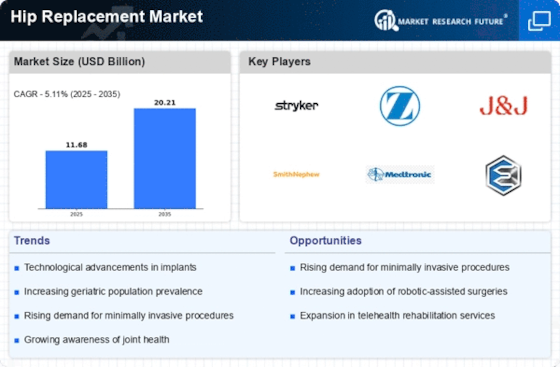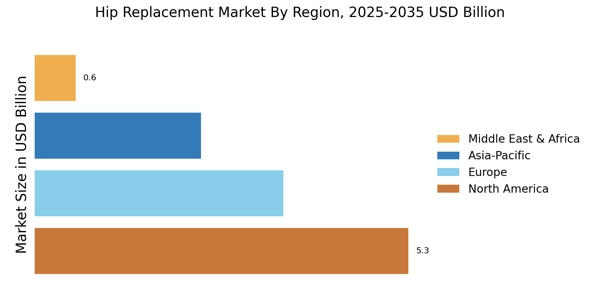Aging Population
The aging population is a primary driver of the Hip Replacement Market. As individuals age, the prevalence of osteoarthritis and other degenerative joint diseases increases, leading to a higher demand for hip replacement surgeries. According to recent data, approximately 30% of individuals aged 65 and older experience significant hip pain, which often necessitates surgical intervention. This demographic shift is expected to continue, with projections indicating that by 2030, the number of people aged 65 and older will reach 1.5 billion. Consequently, the Hip Replacement Market is likely to experience substantial growth as healthcare systems adapt to meet the needs of this expanding population.
Rising Obesity Rates
Rising obesity rates are contributing to the increased demand within the Hip Replacement Market. Obesity is a significant risk factor for developing hip-related conditions, including osteoarthritis, which can lead to the need for surgical intervention. Data suggests that nearly 40% of adults are classified as obese, a figure that has been steadily increasing over the past decade. This trend is concerning, as obesity-related joint issues are expected to drive up the number of hip replacement surgeries. As healthcare providers seek to address the challenges posed by obesity, the Hip Replacement Market may see a corresponding rise in surgical procedures and innovative treatment options.
Technological Innovations
Technological innovations are reshaping the landscape of the Hip Replacement Market. Advancements in surgical techniques, such as minimally invasive procedures and robotic-assisted surgeries, are enhancing patient outcomes and reducing recovery times. For instance, the adoption of 3D printing technology in the production of customized implants is gaining traction, allowing for better fit and functionality. Furthermore, the integration of smart technologies in post-operative care is improving patient monitoring and rehabilitation. These innovations not only enhance the surgical experience but also attract more patients to consider hip replacement as a viable option, thereby propelling growth in the Hip Replacement Market.
Increased Healthcare Expenditure
Increased healthcare expenditure is a significant driver of the Hip Replacement Market. As countries invest more in healthcare infrastructure and services, access to surgical procedures, including hip replacements, improves. Recent statistics indicate that healthcare spending has risen by an average of 5% annually in many regions, reflecting a commitment to enhancing patient care. This trend is likely to continue, as governments and private sectors recognize the importance of addressing musculoskeletal disorders. Consequently, the Hip Replacement Market stands to benefit from this increased investment, leading to more facilities offering hip replacement surgeries and improved patient access to these essential services.
Growing Awareness of Joint Health
Growing awareness of joint health is influencing the Hip Replacement Market positively. As educational campaigns and health initiatives promote the importance of maintaining joint health, more individuals are seeking medical advice for hip-related issues. This heightened awareness is leading to earlier diagnoses and, in some cases, proactive treatment options that may culminate in surgical intervention. Surveys indicate that a significant portion of the population is now more informed about the risks associated with untreated joint problems. As a result, the Hip Replacement Market is likely to see an increase in demand for hip replacement surgeries as individuals prioritize their joint health and seek effective solutions.


















Leave a Comment